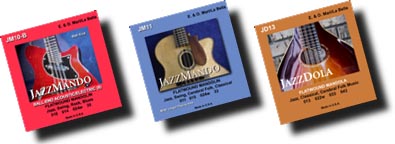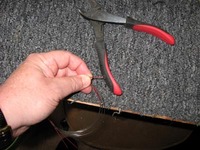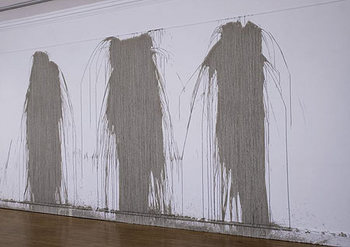« June 2009 |
Main
| August 2009 »
 July 30, 2009 | Build your own flatwound string sets
July 30, 2009 | Build your own flatwound string sets
We've had tremendous success with our JazzMando Family strings. Strung low and light, these flatwound steel strings are the answer to a Maiden's Prayer for the player who plays in closed position more than open strings, as in Jazz, Swing, Cerebral Folk, and Classical music. Players rave about their comfort and their warm tone.

One problem, and it's an issue of a product's strength also being a weakness. The silk wrapping that holds the core down and binds the string at the end of the loop (or ball in the JM10B) can limited the playing area. The strings are also not long enough for the larger scale instruments, the JM11 for a maximum 14-3/8" scale, and the JD13 for a 16-17", let alone octave mandolin or bouzouki. (The JD13 will also not be long enough for some tailpieces, as in the case of a Weber Yellowstone dola, where the inside G & D run short). We've asked Labella about this but they can't make a flatwound without this winding, and the strings are too expensive for us to carry in multiple sizes.
We mentioned in the past our collaboration with D'addario on this, particularly on a string that can double as a mandola OR an octave mandolin; the gauging would be the same. Their process requires no silk wrapping, but despite exhaustive talks that started over two years ago, a pilot prototype is still on the drawing board. The project keeps getting pushed back. See article.) The solution is really quite simple; D'addario is already making this string in their Electric "Chrome" Series for guitar. We've had great success personally making the strings work for acoustic instruments, but it does involve a little minor surgery removing the balls and leaving the loop.
The CG series can be purchased singly; the plain strings come in packs of 10 and the wound in packs of 5. It doesn't hurt to get spares, as it takes a little skill learning how to snip the balls and still leave the loop intact:

 
The trick is to use a high quality set of wire cutters, or better, if you have access to a set of shop end knippers, the job is pretty easy. The brass in the D'addario ball is pretty soft, so with a little careful pressure, they generally break clean and leave the loop intact.
These are the gauges the flatwound Chrome singles come in. This is great if you want to customize your own, and since they are guitar scale, you should be able to use these in longer mandolin family instruments like mandola, octave mandolin, bouzouki, and mandocello.
Item # Product
CG020 Single XL Chromes Flat Wound 020
CG022 Single XL Chromes Flat Wound 022
CG024 Single XL Chromes Flat Wound 024
CG026 Single XL Chromes Flat Wound 026
CG028 Single XL Chromes Flat Wound 028
CG030 Single XL Chromes Flat Wound 030
CG032 Single XL Chromes Flat Wound 032
CG035 Single XL Chromes Flat Wound 035
CG038 Single XL Chromes Flat Wound 038
CG040 Single XL Chromes Flat Wound 040
CG042 Single XL Chromes Flat Wound 042
CG045 Single XL Chromes Flat Wound 045
CG048 Single XL Chromes Flat Wound 048
CG050 Single XL Chromes Flat Wound 050
CG052 Single XL Chromes Flat Wound 052
CG056 Single XL Chromes Flat Wound 056
CG065 Single XL Chromes Flat Wound 065
CG075 Single XL Chromes Flat Wound 075
CG080 Single XL Chromes Flat Wound 080
You can read about availability and pricing here: D'addario Chrome Singles
This is the target set for mandolin (similar to the Labella JM11) with the following gauges:
LE011
LE015
CG024 (loop)
CG036 (loop)
A set that could function as both mandola and oshorter scale ctave mandolin sets. (Gauging between these is not all that different among existing mass market offerings.)
LE013
CG024 (loop)
CG035 (loop)
CG045 (loop) (possibly CG048)
For our JP Charles 10-string, we've arrived at this (14-3/8" scale):
LE011
LE016
CG026 (loop)
CG035 (loop)
CG056 (loop)
The point here is you can experiment, land on something that works for your own instrument. The JP Charles is set up with very low action and we've tweaked the gauges over about a month time settling in on this after much revising. You'll probably want to move slowly yourself on these adjustments.
We're still hoping to see the D'addario Flatwound String Project come through. Last talk at the recent Summer NAMM show is Product Development is still very much committed to this, but several other classical guitar string and internal OEM projects have taken priority.
Posted by Ted at 10:42 AM
 July 23, 2009 | Using comping to understand melodic creation
July 23, 2009 | Using comping to understand melodic creation
 Last week in our "Throwing Mud on the Wall," we looked at the illustration of splashing strategic notes against the backdrop of an improvised solo. The idea was to take a step forward by strategically organizing around known quantities of "appropriate" harmonic notes (3rds & 7ths), connecting them vertically with filler ideas. JazzMando staff Research Assistant, Charlie Jones had some interesting points to add from his own personal experience in looking for "hooks" and comfortable means of dipping one's toe in the creative process: Last week in our "Throwing Mud on the Wall," we looked at the illustration of splashing strategic notes against the backdrop of an improvised solo. The idea was to take a step forward by strategically organizing around known quantities of "appropriate" harmonic notes (3rds & 7ths), connecting them vertically with filler ideas. JazzMando staff Research Assistant, Charlie Jones had some interesting points to add from his own personal experience in looking for "hooks" and comfortable means of dipping one's toe in the creative process:
"I've been looking for motivation to establish 3rds/7ths for skeletal improvisation. Unfortunately, I always get distracted and quickly jump into an 8th note cloud of mayhem. By applying a little mental spin on this and approaching it from a "comping" standpoint, I think I can make some head way in this area. I can even simplify it more by just starting with 7ths, then add 3rds.
Coming at problems like this with simple bite sized solutions is a great approach. It ends up being a hill and not a mountain that you are climbing. You also end up with a nice foundation to build other skills off of. Amazing how we can skim right pass simple, but effective solutions."
Good point, Charlie. The whole point is to start with something both familiar, and not complex. Once you start the process, creative "inertia" will come to you over time as you continue to unravel your own licks and variations of the licks into some kind of physical and mental library over time.
Charlie also brought to our attention a fabulous Dave Fox online article from Learn Jazz Guitar, Creative Guitar Comping. Though the point of the article is to elaborate on the issue of two comping instruments competing in midrange textural density, the solution he proposes, drawing single note phrases is surprisingly applicable to helping beginning improvisers get a grip on soloing. Written for guitarists, it applies equally well to mandolin.
Read article: Creative Guitar Comping
Further
Two-Note Chords
Harmonic Implication
About our relationship
The Fight for Sonic Turf
Don Stiernberg: Axis of the 3rds & 7ths
Posted by Ted at 11:31 AM
 July 16, 2009 | Improvising: Throwing mud on the wall
July 16, 2009 | Improvising: Throwing mud on the wall
Sometimes we let fear and intimidation prevent us from tackling the challenge of creating our own art. The very notion of improvisation strikes terror in the heart of even many advanced players, let alone novices; we steer clear of public (maybe even private) embarrassment, not wanting the responsibility of wrong or inappropriate notes.
Here's a hint: start with some right notes. Look at the chord structure of your chorus and determine the most obvious of notes. Picking out the tonics should be the easiest, but go for something more harmonically relevant like the 3rds of the chords (later the 7ths). These can be your reference points as you splotch pieces of mud on the wall.
Your next step is to work from those points, throwing more "mud" trying to fill in around them. Use passing tones, small licks and riffs, familiar musical phrasings, but think of it not as creating an entire improvised chorus, but as connecting splotches, a network of interrelated notes.
Keep the wall sparse at first, don't give in to the urge to fill it with notes, and again be sure that your 3rds and 7ths are aurally apparent. Drive your in-between notes to them, not just throwing random mud. There's an old saying that if you through enough mud on a wall, eventually it will stick; that's not our goal here! We're not talking about creating a wall of mud, rather a wall of art.

Each chorus is a different wall, although they can be similar. As you build a solo, there will be a climax, or perhaps a series of climactic intensity; those are when your wall will have more mud, but don't underestimate the power of space.
Jazz is all about the balance of calculation and intuition. Start with the calculation, and fill in with the intuition. The big secret is the more experienced you get at it, the more the calculation becomes intuition.
Further:
Improvising: A three-pronged attack
Playing musically: Part 2, play the chords
Analysis: Macroscopes and Microscopes Part 2
Thinking in Sentences
Posted by Ted at 8:33 AM
 July 9, 2009 | How deep is your love?
July 9, 2009 | How deep is your love?
Mel Bay's online webzine "Mandolin Sessions" underwent a recent facelift. Not much changed as far as content format, still the same great writers with absolutely free educational offerings and tunes, but in addition to the cosmetic upgrade, there is now the opportunity for public comments and feedback. Another interesting tool is the information on how many times each article is read.

We try to keep up with these sorts of behind-the-scenes web statistics on the JazzMando site. A routine self-examination lets us know how we are serving our readership. When the numbers are up, we try to look at what issues piqued interest (and attempt to duplicate), and when they start to lag, we try to figure out where we are going wrong.
We noticed on MandolinSessions, the writers who simply contributed tunes, with no cerebral analysis or heavy text tend to get more attention. At least, a higher "reads" number. We discussed with one of our part-time staff assistant editors, Anton Darby, whether or not it would be serve our readership if we got away from deep prose, and his response was we didn't want to go too far to "dumb down," (no disrespect to other fine authors who choose to got the tune route). He felt the JazzMando readership still craved the analytical exercise; even though more players might simply want to just grab a tune or two, we had something special that would afford a mandolinist the option to "go deep." He did suggest starting with a tune, for practical application sake, was a terrific idea, but applauded our efforts to go into the nitty gritty of theory, to look under the hood.
Chances are, if you are a regular here, the detail is what you crave. You can get tunes out of lots of free online resources, but the sort of text we offer is a tad more rare. We hope we have this right, but if you don't agree, we're open to new ideas. We know that Mel Bay offers MandolinSessions to engaged the mandolinist, but ultimately, if readers aren't buying books because of the webzine resource, it would likely go away. Yes, we like to sell books and strings around here, too, but our deeper goal is enlightening a global community on ways to get better at the mandolin.
There is nothing wrong with just wanting to sit on the porch and play tunes. Probably a larger proportion of amateur musicians is wired to approach their music in this way, and while a minority of players are inclined to want to know how a watch is built rather than just knowing what time it is, we are likely to continue to serve in this way.
As always, we appreciate your feedback, and want to know "how deep is your love?"
Browse JazzMando Mandolin Sessions Archives
Further:
Arpeggios and Crossword Puzzles
Arpeggios Math, eggs, and mandolins; higher level understanding
The Regressive Method
Harmonic Implication
The road to harmonic sophistication
Posted by Ted at 2:07 PM
 July 2, 2009 | Arpeggios and Crossword Puzzles
July 2, 2009 | Arpeggios and Crossword Puzzles
There is a spectrum of player that runs from the die-hard, "drill sergeant" devotee, one who likes to pound out scale after scale, arpeggio after arpeggio, and all kinds of physical calisthenics, to the other end, the "Freebird Jammer," one who just wants to play--no rules no boundaries, just willy nilly what comes to the fingers. Between the Boot-camper and the Blower, there resides a happy medium midst this continuum we'll simply call the Crossword Puzzler.
Think about what goes on when someone attacks a crossword puzzle. It's a game, a pastime, but hardly a mindless activity. Anyone who tackles the challenge of word variations required to master a good puzzle ultimately builds personal vocabulary, as well as verbal skill. It requires imagination in hub and spoke of the wheel of context. It's an exercise of the mind totally driven by application.
The best music exercises are ones written with a purpose that transcends physical and sets up the brain for the aesthetic. We try to take this approach in all our drills throughout the JazzMando site and hope you are able to match measure with musical relevance. We explored this in last week's "Math, Eggs, and Mandolins" article, the notion that it's the small, rudimentary math processes that ultimately tie the neurons of the brain into the higher functions of science.
There is a connection and you'll enjoy your practice so much more when you see it.

An eight letter word for "spontaneously invent."
Improvise.
Further:
Chromatic Mastering
'ii V7 I' Major Patterns
'ii7b5 v7 I'minor_patterns
Start your day out with a song
Bringing it home
Posted by Ted at 7:12 AM

Disclaimer: In the 'Information Age' of the 21st Century,
any fool with a computer, a modem, and an idea can
become a self-professed 'expert." This site does not
come equipped with 'discernment.'
|



